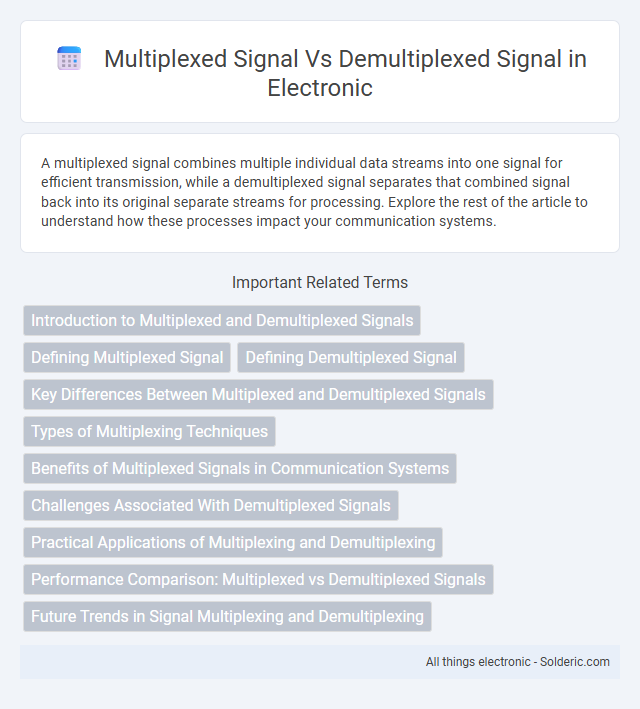A multiplexed signal combines multiple individual data streams into one signal for efficient transmission, while a demultiplexed signal separates that combined signal back into its original separate streams for processing. Explore the rest of the article to understand how these processes impact your communication systems.
Comparison Table
| Feature | Multiplexed Signal | Demultiplexed Signal |
|---|---|---|
| Definition | Combined multiple signals into a single transmission channel | Separated individual signals extracted from a multiplexed signal |
| Purpose | Efficient bandwidth utilization by aggregating signals | Recover original distinct signals for processing or use |
| Signal Composition | Composite signal containing several logical channels | Single, original data stream or signal channel |
| Processing Device | Multiplexer (MUX) | Demultiplexer (DEMUX) |
| Use Case | Transmitting multiple data streams over one medium | Routing signals to designated outputs or devices |
| Example | TDM, FDM, WDM combined channels | Separated time slots, frequency bands, or wavelengths |
Introduction to Multiplexed and Demultiplexed Signals
Multiplexed signals combine multiple data streams into a single transmission channel, optimizing bandwidth efficiency in communication systems. Demultiplexed signals restore these combined streams back into their original, separate data formats at the receiver end, ensuring accurate data retrieval. This process is essential in telecommunications, enabling simultaneous transmission of various signals over shared media.
Defining Multiplexed Signal
A multiplexed signal combines multiple individual signals into one composite signal for transmission over a single communication channel, maximizing bandwidth utilization. This process enables simultaneous transmission of various data streams, such as voice, video, and data, without interference. Demultiplexed signals are the separated original signals retrieved at the receiver end by reversing the multiplexing process.
Defining Demultiplexed Signal
A demultiplexed signal is the result of separating a multiplexed signal into its individual constituent signals, each corresponding to a specific data stream originally combined in the multiplexing process. Demultiplexing is essential in communication systems to restore individual channels for proper data interpretation and processing. Your device relies on demultiplexed signals to accurately extract and handle each unique source of information transmitted over a single communication channel.
Key Differences Between Multiplexed and Demultiplexed Signals
Multiplexed signals combine multiple data streams into a single transmission channel, optimizing bandwidth and reducing infrastructure costs. Demultiplexed signals separate this combined data, directing individual streams to their respective destinations for accurate processing. Understanding these key differences ensures your network efficiently handles data transmission and reception.
Types of Multiplexing Techniques
Multiplexed signals combine multiple data streams into a single channel using techniques such as Time Division Multiplexing (TDM), Frequency Division Multiplexing (FDM), and Wavelength Division Multiplexing (WDM). Demultiplexed signals, on the other hand, separate these combined data streams back into their original channels for individual processing. Understanding these types of multiplexing techniques helps you optimize bandwidth utilization and improve communication efficiency.
Benefits of Multiplexed Signals in Communication Systems
Multiplexed signals enable the transmission of multiple data streams over a single communication channel, significantly increasing bandwidth efficiency and reducing infrastructure costs. By combining signals, your network can support higher data rates and optimize resource utilization, improving overall system performance. This approach also minimizes signal interference and enhances the scalability of communication systems for future expansions.
Challenges Associated With Demultiplexed Signals
Demultiplexed signals face challenges such as signal distortion, crosstalk, and synchronization errors that degrade data integrity. Complex hardware requirements and precise timing control are necessary to accurately separate multiplexed channels. Ensuring signal-to-noise ratio and minimizing latency remain critical issues in demultiplexing processes for high-speed communication systems.
Practical Applications of Multiplexing and Demultiplexing
Multiplexing enables the transmission of multiple signals over a single communication channel, significantly improving bandwidth efficiency in telecommunications and data networks. Demultiplexing is essential at the receiving end to accurately separate combined signals into their original forms, facilitating applications such as cable television, where multiple channels are sent through one cable and then separated for individual viewing. This technology is widely used in fiber optics, satellite communications, and computer networks to optimize the use of available transmission media and reduce infrastructure costs.
Performance Comparison: Multiplexed vs Demultiplexed Signals
Multiplexed signals combine multiple data streams into a single transmission channel, optimizing bandwidth utilization and improving overall network efficiency. Demultiplexed signals separate combined data back into individual streams, enabling accurate and isolated processing but potentially introducing latency due to the overhead of data extraction. Your system's performance depends on the balance between the higher throughput of multiplexing and the precise, manageable signal handling provided by demultiplexing.
Future Trends in Signal Multiplexing and Demultiplexing
Advancements in quantum multiplexing and photonic integrated circuits are set to revolutionize future trends in signal multiplexing and demultiplexing by enhancing bandwidth efficiency and reducing latency. Emerging techniques such as machine learning-driven adaptive multiplexing algorithms optimize signal allocation dynamically across 5G and beyond networks, improving data throughput and network reliability. Integration of AI with WDM (Wavelength Division Multiplexing) and TDM (Time Division Multiplexing) systems promises smarter and more energy-efficient demultiplexing solutions critical for scalable IoT and AI-powered communication infrastructures.
multiplexed signal vs demultiplexed signal Infographic

 solderic.com
solderic.com